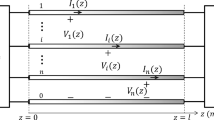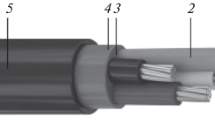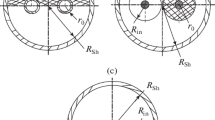Abstract
Background
A strong electromagnetic force is the major cause of vibration in dipole power supply cables. Moreover, the long-term operation of cables under vibration conditions leads to structural fatigue failure.
Purpose and methods
To investigate the cable-laying scheme of a dipole power supply, a finite element model for the electromagnetic–structural coupling between cables and cleats was established. The electrodynamic forces were simulated for fixed-length cables in the horizontal, vertical, and bent models under pulse-current excitation. Subsequently, based on the optimized arrangement mode, the deformation of the cables and the stresses of the cleats were obtained.
Results
A small cable electrodynamic force was observed in the positive–negative interlace arrangement, and the cable deformation was caused by electrodynamic forces. The maximum cleat deformation occurred at the position with the largest electrodynamic force, where the cleats were reinforced. Moreover, the mechanical characteristics of the cables and cleats under pulse-current excitation are described intuitively and quantitatively, providing theoretical support for the cable-laying scheme of the dipole power supply.








Similar content being viewed by others
References
J.C. Yang, J.W. Xia, G.Q. Xiao et al., High intensity heavy ion a ccelerator facility (HIAF) in China. Nucl. Instrum. Methods Phy s. Res. 317, 263 (2013). https://doi.org/10.1016/j.nimb.2013.08.046
W.H. Hayt, Solutions Manual to Accompany Engineering Electromagnetics, 4th edn. (McGraw-Hill Book Co., New York, NY, 1981)
A.W. Booth, A. Hanekom, Why correctly engineered cable cleatsare vital for effective power system protection, in 10th IET International Conference on Developments in Power System Protection. Managing the Change, pp. 1–5 (2010). https://doi.org/10.1049/cp.2010.0362
A. Booth, Why cable cleats are vitally important in the protection of a cable installation. IET Conf. Reliab. Transm. Distrib. Netw. (2011). https://doi.org/10.1049/cp.2011.0528
C.A. Darnell, M.L. Bacon, R.A. Shaw, Cable cleats-a global technique to protect three-phase single conductor cables during short-circuits, in Fifty-First Annual Conference 2004 Petroleum and Chemical Industry Technical Conference, pp. 143–150 (2004). https://doi.org/10.1109/PCICON.2004.1352791
D.A. Weston, Electromagnetic Compatibility: Principles and Applications, 2nd edn. (CRC Press, Boca Raton, 2001)
H.Y. Liu, N. Liu, L.J. Pu et al., ANSYS based analysis on shortcircuitforce and mechanical stress of cleats for high voltage large cross-sectional cables. Trans. China Electrotech. Soc. 31(5), 170–176 (2016). https://doi.org/10.3969/j.issn.1000-6753.2016.05.021
W. Ruger, G. Hosemann, Mechanical short-circuit effects of single-core cables. IEEE Trans. Power Deliv. 4(1), 68–74 (1989). https://doi.org/10.1109/61.19189
X. Wang, C.C. Wang, K. Wu et al., An improved optimal designscheme for high voltage cable accessories. IEEE Trans. Dielectr. Electr. Insul. 21(1), 5–15 (2014). https://doi.org/10.1109/TDEI.2013.004102
M. Steurer, K. Fröhlich, The impact of inrush currents on the mechanical stress of high voltage power transformer coils. IEEE Trans. Power Deliv. 17(1), 155–160 (2002). https://doi.org/10.1109/61.974203
A.A. Adly, Computation of inrush current forces on transformer windings. IEEE Trans. Magn. 37(4), 2855–2857 (2001). https://doi.org/10.1109/20.951327
H.J. Zhang, B. Yang, W.J. Xu et al., Dynamic deformation analysis of power transformer windings in short-circuit fault by FEM. IEEE Trans. Appl. Supercond. 24(3), 0502204 (2014). https://doi.org/10.1109/TASC.2013.2285335
Y.Q. Liu, S.H. Wang, X.J. Meng et al., Kinetic characteristics of transformer windings under short circuit condition. Int. J. Appl. Electrom. Mech. 33(1–2), 457–464 (2010). https://doi.org/10.3233/JAE-2010-1145
H.M. Ahn, Y.H. Oh, J.K. Kim et al., Experimental verificationand finite element analysis of short-circuit electromagnetic force for dry-type transformer. IEEE Trans. Magn. 48(2), 819–822 (2012). https://doi.org/10.1109/TMAG.2011.2174212
H.M. Ahn, J.Y. Lee, J.K. Kim et al., Finite-element analysis ofshort-circuit electromagnetic force in power transformer. IEEE Trans. Ind. Appl. 47(3), 1267–1272 (2011). https://doi.org/10.1109/TIA.2011.2126031
A. Benhama, A.C. Williamson, A.B.J. Reece, Computation of electromagnetic forces from finite element field solutio ns, in 1996 Third International Conference on Computati on in Electromagnetics, pp. 247–252 (1996). https://doi.org/10.1049/CP:19960193
Swanson Analysis System, Inc., “ANSYS Academic Research.”Ansys.com. http://www.ansys.com (accessed Sep. 18, 2022)
Y.J. Yu, X.X. Wang, Z.H. Chen, A simplified finite element model for structural cable bending mechanism. Int. J. Mech. Sci. 113, 196–210 (2016). https://doi.org/10.1016/j.ijmecsci.2016.05.004
F.P. Nasution, S. Sævik, S. Berge, Experimental and finiteelement analysis of fatigue strength for 300mm2 copper power conductor. Mar. Struct. 39, 225–254 (2014). https://doi.org/10.1016/j.marstruc.2014.07.005
H. Böhme, F. Golletz, C. Fiebiger, Mechanical stress in high-voltage switchgear with flexible single conductors under short-circuit current load. Eur. Trans. Electr. Power. 1, 31–35 (1991). https://doi.org/10.1002/etep.4450010108
Author information
Authors and Affiliations
Corresponding author
Rights and permissions
Springer Nature or its licensor (e.g. a society or other partner) holds exclusive rights to this article under a publishing agreement with the author(s) or other rightsholder(s); author self-archiving of the accepted manuscript version of this article is solely governed by the terms of such publishing agreement and applicable law.
About this article
Cite this article
Zhang, R., Feng, A., Liu, Y. et al. Simulation research on cable-laying scheme of HIAF dipole power supply. Radiat Detect Technol Methods 7, 149–158 (2023). https://doi.org/10.1007/s41605-022-00371-z
Received:
Revised:
Accepted:
Published:
Issue Date:
DOI: https://doi.org/10.1007/s41605-022-00371-z




